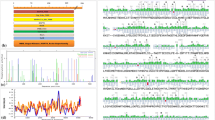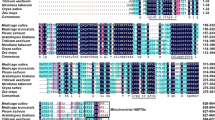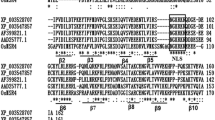Abstract
The accumulation of various heat shock proteins (HSPs) and their relationship with the inbuilt cold tolerance observed in Kashmir Basmati was studied. Five Basmati rice verities (Oryza sativa), Basmati-370, Basmati-Pak, Basmati-198, Basmati-385 and Kashmir Basmati were given temperature shock of 45 and 50°C. Temperature shocks were given for 16 h in incubator preheated to 45 and 50°C and 85% relative humidity. Proteins were extracted and separated on 10% acrylamide gels with 1 mm thickness and visualized for protein fractions. Accumulation of 40 kDa HSPs were observed in all the cultivars, and 20 kDa HSPs specifically in Kashmir Basmati. Small amounts of high molecular weight HSPs were observed in un-treated (control) plants of Kashmir Basmati, and it increased considerably after heat shock. The 20 kDa HSP was only expressed in heat-treated Kashmir Basmati. Differences in the expression of heat shock proteins in the tested varieties have been described in detail.


Similar content being viewed by others
References
Adnan S, David W, Susan L (1996) The correlation between heat-shock protein accumulation and persistence and chilling tolerance in tomato fruit. Plant Physiol 110:531–537. doi:10.1104/pp.110.2.531
Anderson JV, Li Q-B, Haskell DW, Guy CL (1994) Structural organization of the spinach endoplasmic reticulum-luminal 70-kilodalton heat-shock cognate gene and expression of 70-kilodalton heat-shock genes during cold acclimation. Plant Physiol 104:1359–1370. doi:10.1104/pp.104.4.1359
Anonymous (1982) Ten years of NIAB: second five years report of scientific activities. Nuclear Institute for Agriculture and Biology (NIAB), Faisalabad, Pakistan, pp 25–32
Anonymous (1987) Fifteen years of NIAB: third five years of scientific activities. Nuclear Institute for Agriculture and Biology (NIAB), Faisalabad, Pakistan, pp: 9–16
Anonymous (2001) Special report FAO/WFP crop and food supply assessment mission to Pakistan
Arrigo AP (1998) Small stress proteins: chaperones that act as regulators of intracellular redox state and programmed cell death. Biol Chem 379:19–26
Awan MA, Cheema AA (1985) New mutant genes for early maturity and dwarfism in Basmati rice. In: Proc. Nat. Seminar on Rice Research and Production, held at Kala Shah Kaku, Lahore, Pakistan, April 25–27, 1985, pp 7–13
Awan MA, Bari B, Cheema AA, Akbar M (1977) List of mutant varieties. Mut Breed News 1:15
Bartels D, Furini A, Ingram J, Salamini F (1997) Responses of plants to dehydration stress: a molecular analysis. In: Belhassen E (ed) Drought tolerance in higher plants: genetical, physiological and molecular biological analysis. Kluwer, Dordrecht
Bauman JW, Liu J, Klassen CD (1993) Production of metallothionein and heat shock proteins in response to metals. Fundam Appl Toxicol 21:15–22. doi:10.1006/faat.1993.1066
Bharadwaj S, Adnan A, Ovsenek N (1999) Multiple components of the HSP90 chaperone complex function in regulation of HSF1 in vivo. Mol Cell Biol 19:8033–8041
Blum H, Beier H, Gross H (1987) Improved silver staining of plant proteins. RNA and DNA in polyacrylamide gels. Electrophoresis 8:93–99. doi:10.1002/elps.1150080203
Boreham DR, Mitchel RE (1994) Regulation of heat and radiation stress responses in yeast by hsp-104. Radiat Res 137:190–195. doi:10.2307/3578811
Bradford MM (1976) A rapid and sensitive method for quantitation of microgram quantities of protein utilizing the principle of protein-dye-binding. Anal Biochem 72:248–254. doi:10.1016/0003-2697(76)90527-3
Bray E (1997) A plant response to water deficit. Trends Plant Sci 2:48–54. doi:10.1016/S1360-1385(97)82562-9
Bukau B, Horwitch AL (1998) The HSP-70 and HSP-60 chaperon machines. Cell 92:351–366
Cabané M, Calvet P, Vincens P, Boudet AM (1993) Characterization of chilling-acclimation-related proteins in soybean and identification of one as a member of the heat shock protein (HSP 70) family. Planta 190:346–353. doi:10.1007/BF00196963
Cellier F, Conejero G, Breitler JC, Casse F (1998) Molecular and physiological responses to water deficit in drought tolerant and drought sensitive lines of sunflower: accumulation of dehydrin transcripts correlates with tolerance. Plant Physiol 116:319–328. doi:10.1104/pp.116.1.319
Drummond IA, Steinhardt RA (1987) The role of oxidative stress in the induction of Drosophila heat-shock proteins. Exp Cell Res 173:439–449. doi:10.1016/0014-4827(87)90284-9
Farooq S, Iqbal N, Arif M (1998) Detection of genetic variability in Basmati and non-Basmati rice varieties and their radiation induced mutants through Random Amplified Polymorphic DNA (RAPD). In: Technical Document N0. 1010. Research Coordinated Programme on “Application of DNA based marker mutations in sexually propagated cereal crops”. International Atomic Energy Agency (IAEA), Vienna, Austria, pp 85–96
Feder ME (1999) Heat-shock proteins, molecular chaperones and the stress response: evolutionary and ecological physiology. Annu Rev Physiol 61:234–282. doi:10.1146/annurev.physiol.61.1.243
Giorini S, Galili G (1991) Characterization of HSP-70 cognate proteins from wheat. TAG 82:615–620
Jakob U, Gaestel M, Engel K, Buchner J (1993) Small heat shock proteins are molecular chaperones. J Biol Chem 268:151–1520
James P, Pfund C, Craig EA (1994) Functional specificity among Hsp-70 molecular chaperones. Science 275:387–389. doi:10.1126/science.275.5298.387
Kim R, Kim KK, Yokota H, Kim SH (1998) Small heat shock protein of Methanacoccus jannaschii, a hyperthemophile. Proc Natl Acad Sci USA 95:9129–9133. doi:10.1073/pnas.95.16.9129
Krishna P, Sacco M, Cherutti JF, Hill S (1995) Cold-induced accumulation of hsp90 transcripts in Brassica napus. Plant Physiol 107:915–923
Laemmli UK (1970) Cleavage of structure proteins assembly of the head of bacteria-phage T4. Nat 22:680–685. doi:10.1038/227680a0
Lee GJ, Pokala N, Vierling E (1995) Structure and in vitro molecular chaperone activity of cytosolic small heat shock proteins from pea. J Biol Chem 270:10432–10438. doi:10.1074/jbc.270.18.10432
Millar AA, Dennis E (1996) Protein synthesis during oxygen deprivation in cotton. Aust J Plant Physiol 23:341–348
Morimoto RI (1997) The heat shock response: regulation and functions of heat-shock proteins and molecular chaperones. Essays Biochem 32:17–29
Neven LG, Haskell DW, Guy CL, Denslow N, Klein PA, Green LG, Silverman A (1992) Association of 70-kilodalton heat-shock cognate proteins with acclimation to cold. Plant Physiol 99:1362–1369. doi:10.1104/pp.99.4.1362
Pareek A, Singla SL, Grover A (1995) Immunological evidence for accumulation of two high-molecular-weights (104 and 90 kDa) HSPs in response to different stresses in rice and in response to high temperature stress in diverse plant genera. Plant Mol Biol 29:293–301. doi:10.1007/BF00043653
Plater ML, Goode D, Carbbe MJC (1996) Effects of site-directed mutations on the chaperone-like activity of α B-crystallin. J Biol Chem 271:28558–28566. doi:10.1074/jbc.271.45.28558
Polla BS (1998) A role of heat shock proteins in inflammation. Immunol Today 9:134–137. doi:10.1016/0167-5699(88)91199-1
Scharf KD, Siddique M, Vierling E (2001) The expanding family of Arabidopsis thaliana small hat stress proteins and a new family of proteins containing α-crystallin domains (Acd proteins). Cell Stress Chaperones 6:225–237. doi:10.1379/1466-1268(2001)006<0225:TEFOAT>2.0.CO;2
Shinozaki K, Yamaguchi-Shinozaki K (1997) Gene expression and signal transduction in water-stress response. Plant Physiol 115:327–334. doi:10.1104/pp.115.2.327
Singla SL, Pareek A, Grover A (1998) Plant HSP 100 family with special reference to rice. J Biosci 23:337–345. doi:10.1007/BF02936126
Ukaji N, Kuwabara C, Takezawa D, Arakawa K, Yoshida S, Fujikawa S (1999) Accumulation of small heat-shock protein homologs in the endoplasmic reticulum of cortical parenchyma cells in mulberry in association with seasonal cold acclimation. Plant Physiol 120(2):481–490
Vierling E (1991) The roles of heat shock proteins in plants. Annu Rev Plant Physiol Plant Mol Biol 42:579–620. doi:10.1146/annurev.pp.42.060191.003051
Zeng SY, Wang M, Li M, Zeng SX, Wang YR, Li MR (1997) Protein change in rice seedlings during enhancement of chilling resistance by different stress pretreatments. Acta Bot Sin 39:130–136
Author information
Authors and Affiliations
Corresponding author
Rights and permissions
About this article
Cite this article
Iqbal, N., Farooq, S., Arshad, R. et al. Differential accumulation of high and low molecular weight heat shock proteins in Basmati rice (Oryza sativa L.) cultivars. Genet Resour Crop Evol 57, 65–70 (2010). https://doi.org/10.1007/s10722-009-9451-1
Received:
Accepted:
Published:
Issue Date:
DOI: https://doi.org/10.1007/s10722-009-9451-1




